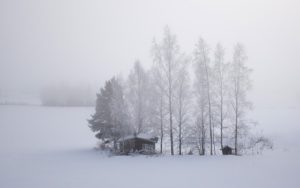Today marks the winter solstice, in which we celebrate the darkest day of the year. What we’re really celebrating is that light is slowly returning to our world in the form of incrementally longer days. There’s an element of triumph associated with the solstice, in that we made it through the darkest days of the year. What’s often missed is that these cold, dark days are an important component in sustaining our health, and the health of all living things.
Right now in Minnesota, the landscape looks dead. The trees are devoid of leaves and the fields are crispy and brown with dried leaves and litter  from the grasses and wildflowers of last summer. However, the trees and grasses aren’t dead, but are in a kind of suspended animation. Yes, their leaves are gone, but there’s still life in the roots and core of each plant. This dormant period is a time for plants to stop growing for a while, take a rest, and conserve energy so they can leaf out again in the spring.
from the grasses and wildflowers of last summer. However, the trees and grasses aren’t dead, but are in a kind of suspended animation. Yes, their leaves are gone, but there’s still life in the roots and core of each plant. This dormant period is a time for plants to stop growing for a while, take a rest, and conserve energy so they can leaf out again in the spring.
Trees and plants aren’t the only living things that go dormant in the winter. Many animals, such as bears, skunks, raccoons, reptiles, and even insects hibernate in the winter. Their body temperature cools down and their heart rate and respiration slow, all as a way to survive the cold and protect their energy stores until the warmer weather returns.
In Chinese theory, each season is associated with an energetic task that’s hardwired into the DNA of plants and animals. And knowing the task for each season is a key to good health, but also keeps you in touch with the natural world. For example, spring is a time of expansiveness. Birds migrate north to nest, hibernating animals become active again, the sap starts running in trees and they being to sprout leaves. Summer is active with nesting, mating, and raising young. In the fall, animals look for an abundance of food to provide energy for the coming winter. And the seasonal task of winter is dormancy; to slow down, store energy, and regenerate in the coming spring.
While animals know this instinctively, we humans also feel these seasonal tasks, but our signals are somewhat muted, perhaps because we’ve lived indoors for thousands of years. But the pull of the seasons is also still deep in our DNA. It’s found in the urge to go outside to run and play on the first warm days of spring. It’s found in the bright activity of summer, and it’s found during the fall harvest when we gravitate toward heartier fare of winter squash, root vegetables, soups, and stews.
Which brings us to winter. I’ve been bemoaning the couple extra pounds my scale says I’ve gained in the last month or so. I feel just a little bit guilty for staying in bed later in the morning or shuffling off to take a nap some afternoons. And even though I get outdoors every day, I struggle to want to go outside and walk the hiking paths and trails that I so loved during the summer. Rationally, I know that this is what my body is supposed to do during the coldest and darkest days of winter—to practice dormancy. I will just say okay to the extra carbs that somehow end up on my dinner plate, and I’ll indulge in a few holiday sweets. I’ll try to be okay with weighing a little more and sleeping a little longer, because this is what’s expected of winter.
hiking paths and trails that I so loved during the summer. Rationally, I know that this is what my body is supposed to do during the coldest and darkest days of winter—to practice dormancy. I will just say okay to the extra carbs that somehow end up on my dinner plate, and I’ll indulge in a few holiday sweets. I’ll try to be okay with weighing a little more and sleeping a little longer, because this is what’s expected of winter.
The lesson of winter is this: You’re meant to slow down, build up a little energy, and take the time to restore your health. The extra energy that you build up during winter helps to keep you warm, fuel your metabolism, and support your immune system. So allow yourself to eat heavier meals, be okay with an extra pound or two, get a little extra sleep, and know that this is what your body needs during the winter.



